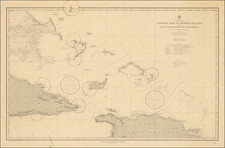An Important Early Map / Graphic Illustrating Cuba's History
Rare second state of Bernardo May's map of Cuba, one of the richest images of Cuba printed in the 19th century.
May's map includes a remarkable (almost daily) reconstruction of routes of the earliest discoverers / explorers of Cuba. The note at the left identifies the different symbols shown for the depiction of four important early explorations:
- The First Voyage of Columbus
- The Second Voyage of Columbus
- The Fourth Voyage of Columbus
- The Voyage of Diego Velazquez in 1511
On the island itself, May' lists numerous dates in the early 16th Century, corresponding with important historical events in the first several decades after the Spanish first arrived in Cuba, including notes on Ponce de Leon's contact with Florida in 1512, Antonio Alaminos's discovery of the New Bahamas Channel in 1519 and Columbus's discoveries in the Bahamas in 1492.
May's map is surrounded by numerous illustrations of historical scenes of the discovery and early history of Cuba, including portraits of Bartolome de Las Casas and Diego Velazquez.
The images are based on the very important early views produced in Cuba by its first lithographer, F. Mialhe. So influential was his work throughout the Americas and Europe that Emilio Cueto asserts: "The image which the enlightened public of the nineteenth century had of Cuba was the one conveyed by Mialhe"--p. 6. Among the subjects of the illustrations are the cultivation of tobacco, a formal dance, a cock fight, a hurricane at its height, various regional domiciles, etc. The plan of Havana includes a view of the city from the harbor.
The genesis of these works involves a fascinating case of graphic piracy. May, a Havana merchant, sent without authorization a number of Mialhe's original views to Germany to be re-lithographed. These were then sent back to Cuba, where May sold them at a price that undercut Mialhe's. Although Mialhe brought suit, the case was settled to May's advantage because Mialhe failed to follow the exact procedures of the then newly enacted copyright laws.
May's maps are, however, more 'original' than May's other piracies of Mialhe, since Mialhe never prepared a map.
Rarity
This is the first example of the "second state" of the map we have seen on the market. We note examples of the first state (1847) at the Bibliotheque National de France, Spanish Ministry of Defense
While Bernardo May's Modern Cuba map and his Modern Plan of Havana appear occasionally on the market, this "Historical" map is apparently very rare.









![Island of Cuba (Spanish) and Jamaica (British) [also South Florida, Bahamas and Cayman Islands]](https://storage.googleapis.com/raremaps/img/small/98323.jpg)
![[ Cuba ] Carte Reduite de l'Isle de Cube Dressee au Depot des Cartes et Plans de la Marine Pour le Service des Vaisseaux du Roy Par Ordre de Mle Duc de Choiseeul . . . Par le S. Bellin Ingenieur de la Marine et du Depost des Plans . . . M. DCC. LXII](https://storage.googleapis.com/raremaps/img/small/54756.jpg)
![Grand Bay of Nipe on the North side of Cuba from Spanish Draughts [on sheet with:] Plan of Puerto de Baracoa](https://storage.googleapis.com/raremaps/img/small/89453.jpg)
![[Hispaniola, Cuba, Martinique and Guadalupe] Carte de S.Domingue . . . / Carte de Cuba . . . / Carte de Martinique . . . / Carte de Guadalupe et des Isles de Saintes . .](https://storage.googleapis.com/raremaps/img/small/70543.jpg)
![Cuba Insula [with] Hispaniola Insula [with] Insula Jamaica [with] Ins. S. Ioannis [with] I.S. Margareta Cum Confiniis](https://storage.googleapis.com/raremaps/img/small/95802.jpg)
